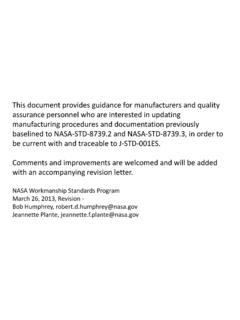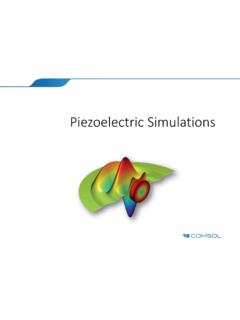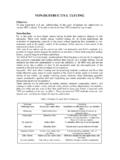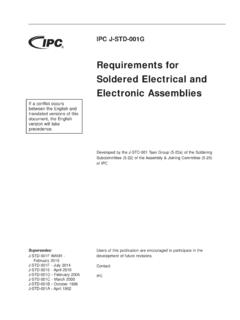Transcription of Spill Prevention, Control and Countermeasure Plan (SPCC ...
1 1 United States Environmental Protection Agency Office of Emergency Management August 2013 Spill Prevention, Control and Countermeasure Plan (SPCC) Program Bulk Storage Container Inspection Fact Sheet The inspection requirements of the SPCC rule are designed to detect oil leaks, spills, or other potential integrity or structural issues before they can result in a discharge of oil to navigable waters of the or adjoining shorelines. Regularly scheduled inspections, evaluations, and testing of bulk oil storage containers by qualified personnel are critical parts of discharge prevention. A container integrity inspection and/or testing program may involve one or more of the following: an external visual inspection of containers, foundations, and supports; non-destructive testing (examination) to evaluate integrity of certain containers; and additional evaluations, as needed, to assess the containers fitness for continued service.
2 The type of inspection program and its scope will depend on site specific condition and the application of good engineering practices and this can be accomplished by following applicable industry standards. What oil storage containers do I have to inspect at my facility? Conduct integrity testing and routinely inspect the following aboveground bulk storage containers with a capacity of 55 gallons or more: Large (field-constructed or field-erected) and small (shop-built) bulk storage containers; Containers located on, partially in (partially buried, bunkered, or vaulted tanks), and off the ground wherever located; and Double-walled containers. Oil filled equipment is not a bulk storage container and, therefore, not subject to the integrity testing requirements of the SPCC rule. How do I inspect aboveground bulk storage containers? The SPCC rule requires that you: Test or inspect each container for integrity on a regular schedule and whenever you make material repairs; and Frequently inspect the outside of the container for signs of deterioration, discharges, or accumulation of oil inside diked areas.
3 This visual inspection is intended to be a routine walk-around and include the container s supports and foundations. Identify in your SPCC Plan the type and frequency of testing and inspection for each container and the appropriate qualifications of personnel performing the tests and inspections. You must retain testing and inspection records for 3 years. EPA recommends that formal test records or reports be retained for the life of the container. Integrity testing is required for all aboveground bulk storage containers located at onshore facilities (except oil production facilities). Integrity testing is necessary to determine if the container ( a tank) is suitable for continued use until the next formal inspection. (c)(6), (c)(6)(i) Test or inspect each aboveground container for integrity on a regular schedule and whenever you make material repairs. You must determine, in accordance with industry standards, the appropriate qualifications for personnel performing tests and inspections, the frequency and type of testing and inspections, which take into account container size, configuration, and design (such as containers that are: shop-built, field-erected, skid-mounted, elevated, equipped with a liner, double-walled, or partially buried).
4 Examples of these integrity tests include, but are not limited to: visual inspection, hydrostatic testing, radiographic testing, ultrasonic testing, acoustic emissions testing, or other systems of non-destructive testing. You must keep comparison records and you must also inspect the container's supports and foundations. In addition, you must frequently inspect the outside of the container for signs of deterioration, discharges, or accumulation of oil inside diked areas. Records of inspections and tests kept under usual and customary business practices satisfy the recordkeeping requirements of this paragraph. Note: The above text is an excerpt of the SPCC rule. Refer to the full text of 40 CFR part 112. Bulk Storage Container Inspection Fact Sheet August 2013 Office of Emergency Management 2 Depending on the type of container, integrity testing may be as simple as an external visual inspection or may involve more complicated methods of non-destructive testing such as Magnetic Flux Leakage (MFL) or ultrasonic thickness (UT) measurements, vacuum box testing, and weld inspection in order to adequately assess the container condition.
5 While frequent external visual inspections can often be completed by trained facility personnel, the requirement to conduct regular integrity tests or inspections may involve hiring specialized personnel (as specified by the applicable industry standard). For example, integrity testing of field-erected aboveground storage tanks in accordance with API 653 involves formal in-service external inspections and formal out-of-service internal inspections to be conducted by an API 653 certified inspector. A formal in-service external inspection involves visual inspection and UT measurements of the shell. A formal out-of-service internal inspection determines the condition of the tank s floor, walls and structure, but should also include the shell, roof, nozzles, and tank appurtenances. The out-of-service inspection typically includes non-destructive testing such as MFL scanning of the floor, vacuum box testing floor welds, helium leak testing, UT measurements, and tank bottom settlement measurements.
6 How do I develop a program for inspecting and/or testing my containers? First, you, or a registered Professional Engineer (PE), determine which industry standards are applicable. Then, in accordance with the industry standards determine: The appropriate qualifications for personnel performing tests and inspections; and The frequency and type of testing and inspections. This must take into account the aboveground container size, configuration, and design ( , shop-built, field-erected, skid-mounted, elevated, equipped with a liner, double-walled, or partially buried). Industry standards describe procedures to identify the condition of the container through formal internal and external inspections conducted by certified personnel. For internal inspections, the container must typically be taken out of service, cleaned, and made ready for personnel to enter the container. Examples of these integrity tests include, but are not limited to: visual inspection, radiographic examination, UT, MFL scanning, helium leak testing, magnetic particle examination, liquid penetrant examination, acoustic emissions testing, hydrostatic testing, inert gas leak testing or other methods of non-destructive examination.
7 Acoustic emission testing and UT robotic measurement are non-destructive examination methods that can be used while the tank is in-service. Acoustic emission testing is used to determine if there is a leak but does not determine if there is corrosion or metal loss. Hydrostatic testing is typically performed on new tanks and on existing tanks that have had major repairs or alterations. Industry standards may use one, or a combination, of these non-destructive examination methods or tests as part of an integrity testing program. If you have containers that have never been inspected for integrity then, depending on their size and configuration, industry standards may require that you assess baseline conditions for these containers. What are industry standards? Industry standards are technical guidelines created by experts in a particular industry for use throughout that industry. Standards-developing organizations use a consensus process to establish the minimum accepted industry practice.
8 The SPCC rule requires that the Plan be prepared in accordance with good engineering practice. Standards play a role in determining good engineering practice when developing Spill prevention procedures and an inspection program for an SPCC-regulated facility. Implementing an inspection program based on a particular industry standard is ultimately up to the owner/operator. When an owner/operator indicates in the SPCC Plan that he intends to use a standard to comply with a particular rule requirement ( integrity testing), then it is mandatory to implement the relevant portions of the standard ( those that address integrity testing of the container). The American Petroleum Institute (API) Standard 653, Tank Inspection, Repair, Alteration, and Reconstruction and the Steel Tank Institute (STI) SP001 Standard for the Inspection of Aboveground Storage Tanks (STI SP001) are two commonly used inspection standards for aboveground bulk storage Bulk Storage Container Inspection Fact Sheet August 2013 Office of Emergency Management 3 The industry standard you or your PE identifies in your SPCC Plan outlines the specific inspection and integrity testing protocol for the containers at your facility.
9 These protocols may vary depending on the size and configuration of your containers. For example, portable containers ( a drum) have fewer inspection requirements than shop-built and field-erected containers. Who can help me establish an integrity inspection and/or testing program for my bulk storage containers? If your SPCC Plan will be certified by a Professional Engineer (PE) then the PE will work with you to establish an inspection and/or testing program that is appropriate for the types of containers at your facility. The PE may consider industry standards and consult with tank inspectors to determine the frequency, type of testing and inspections and the appropriate qualifications for personnel performing the tests and inspections. If you have a qualified facility and are planning to self-certify your SPCC Plan, then you can develop your inspection and/or testing program by following the protocols identified in the industry standards applicable for your oil storage containers or by contacting tank inspection professionals.
10 Industry standards, such as API 653 and STI SP001 contain requirements to inspect aboveground containers. If you deviate from the requirements of the standards, then you can do so in accordance with the environmental equivalence provision in (a)(2) and have a PE certify that portion of your SPCC Plan. How often do I have to perform inspections or tests? Testing on a regular schedule means testing per industry standards or at a frequency sufficient to prevent discharges. Industry standards establish the scope and frequency for inspections that considers the particular conditions of the aboveground container. These conditions may include the age, service history, original construction specifications ( , shop-built vs. field-erected, welded steel vs. riveted steel), prior inspection results, and the existing condition of the container. It may also consider the degree of risk of a discharge to navigable waters or adjoining shorelines, containers that are located near saltwater where an accelerated corrosion rate would be expected.

















